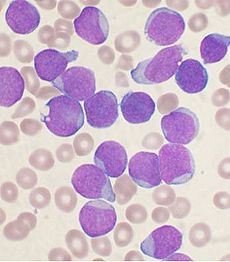Leukemia strikes all ages and both sexes. There are many symptoms of leukemia. The symptoms of leukemia are the same for all the different types of leukemia. The acute types of leukemia, ALL and AML, symptoms are seen more quickly than in the chronic types of leukemia, CLL and CML, where symptoms do not necessarily appear right away. The symptoms are flu symptom, weakness, fatigue, constant infections, easily bleed and bruise, loss of weight and appetite, swollen lymph nodes, liver or spleen, paleness, bone or joint pain, excess sweating, swollen or bleeding gums, nosebleeds and other hemorrhages, and red spots called petechiae located underneath the skin. In acute Leukemia the cancerous cells may collect around the central nervous system. The results can include headaches, vomiting, confusion, loss of muscle control, or seizures. These clumps of cancer cells can collect in other various parts of the body (MedicineNet-leukemia, 1997 and American Cancer Society-leukemia, 1995).
Leukemia can be diagnosed in a number of ways. Blood work is commonly done in the laboratory. Different forms of blood work  include checking the hemoglobin count, platelet count, or white blood cell count. X-rays are routinely done for treatment follow-up. Ultrasound is also used as a treatment follow-up. CT Scan is a special type of x-ray used as a detailed cross section of a specific area of the body. Bone marrow is routinely tested to examine progress of the disease. Spinal taps are also used in certain types of cancers. The spinal fluid is checked to see if cancer cells are present (Parent and Patient handbook-hematology/oncology clinic, Children’s Hospital of Michigan, 19??)
include checking the hemoglobin count, platelet count, or white blood cell count. X-rays are routinely done for treatment follow-up. Ultrasound is also used as a treatment follow-up. CT Scan is a special type of x-ray used as a detailed cross section of a specific area of the body. Bone marrow is routinely tested to examine progress of the disease. Spinal taps are also used in certain types of cancers. The spinal fluid is checked to see if cancer cells are present (Parent and Patient handbook-hematology/oncology clinic, Children’s Hospital of Michigan, 19??)
Treatment of Leukemia is very complex. Treatments are tailored to fit each patient’s needs. The treatment depends on the type of the cancer and features of the cells. It also depends on the patient’s age, symptoms, and general health. Acute Leukemia must be treated immediately. The goal of treatment is to get the cancer into remission. Many people with Leukemia may be cured. To be considered cured; you must be cancer free for at least five years. This time also varies depending on the type of cancer. The most common treatment of Leukemia is chemotherapy. Bone marrow transplants, Radiation, or biological therapy are also available options. Surgery is also occasionally used. Chemotherapy is a treatment method in which drugs are given to kill off the cancerous cells. One or more drugs may be used depending on the type of Leukemia. Anticancer drugs are usually given by IV injection. Occasionally they are given orally. Chemotherapy is given in cycles: a treatment period followed by a recovery period followed by another treatment period and this process continues for a certain amount of time. Radiation therapy is used along with chemotherapy in some occasions. Radiation uses high energy beams to kill the cancerous cells. Radiation can be applied to either one area or to the whole body. It is applied to the whole body before bone marrow transplants. Bone marrow transplants are used in certain patients. The patient’s bone marrow is killed by high doses of drugs and radiation. The bone marrow is then replaced by a donor’s marrow or the patient’s marrow that was remove before the high amounts of drugs and radiation. Biological therapy involves substances that affect the immune system’s response to the cancer(MedicineNet-leukemia, 1997).
In conclusion, Leukemia can be fatal, but with early diagnosis, proper treatments, and a lot of luck, it can be put into remission. With treatment options improving constantly, there may one day be a sure cure. Leukemia is a very dominant disease and very hard to treat. The key may be in the causes.
